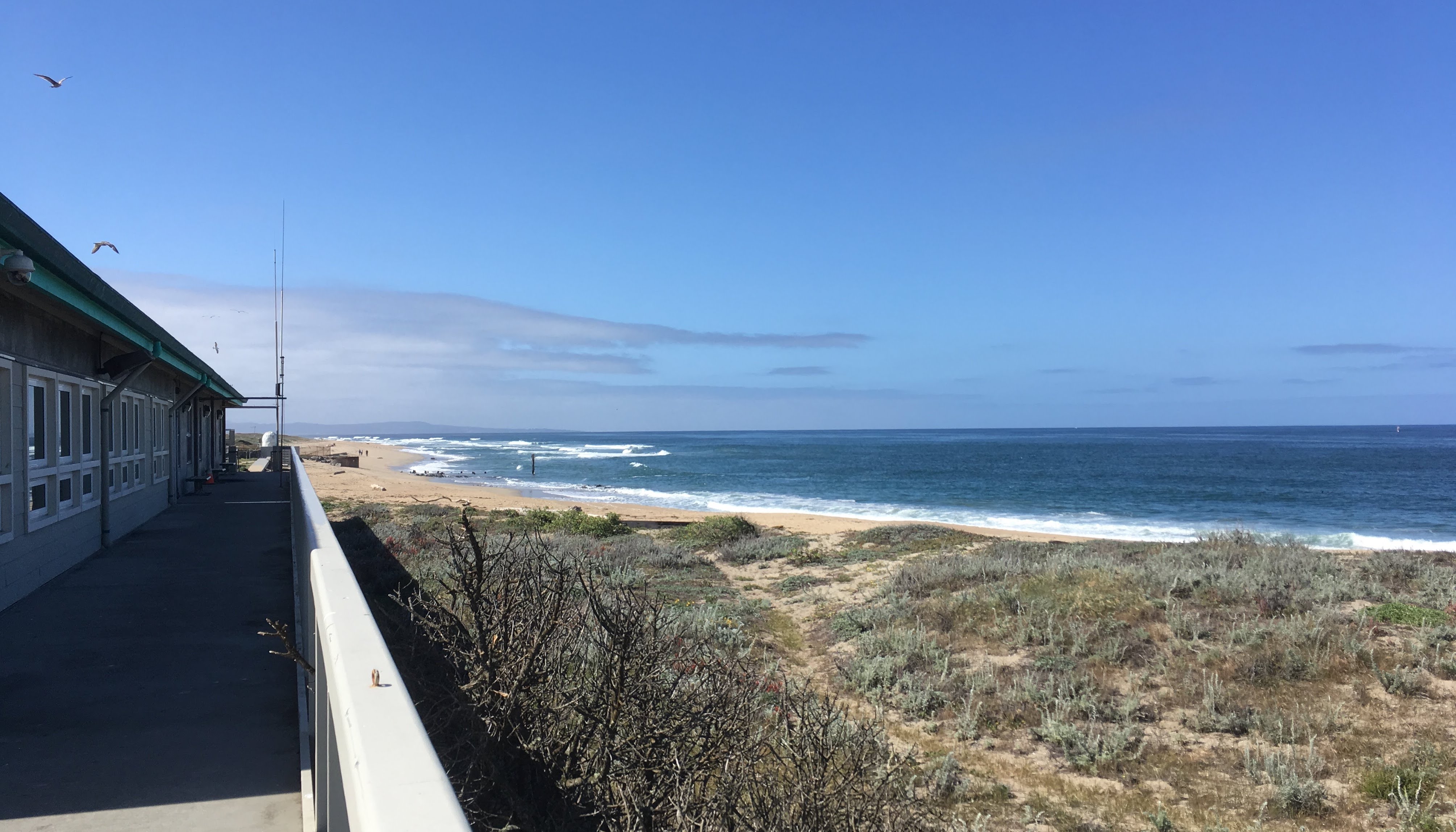From early 2018 through much of 2019, I worked at the Monterey Bay Aquarium Research Institute (MBARI) on an effort to tag and track jellyfish in the wild. I had graduated in 2016 burnt out to the core and with the creative capacity of a sack of potatoes, and probably would’ve preferred hibernating in a Slovakian ice cave to starting a job had it been financially viable. After a tired year in industry, I left. I wasn’t sure what I wanted to do, except that I had the distinct sense I’d crushed something I loved to death, and I wanted it back, whatever it was. I’d always loved the ocean, for mostly sentimental and unscientific reasons, but now the thought came to me—why not work on it? I didn’t know anything about the ocean, formally. I didn’t know anything about biology, formally. But I figured that I didn’t really know anything about anything, and also, I’d forgotten how to care about looking like an idiot.
I cold-emailed a bunch of people working on and in the ocean. One of them, Kakani Katija at MBARI, got back to me.

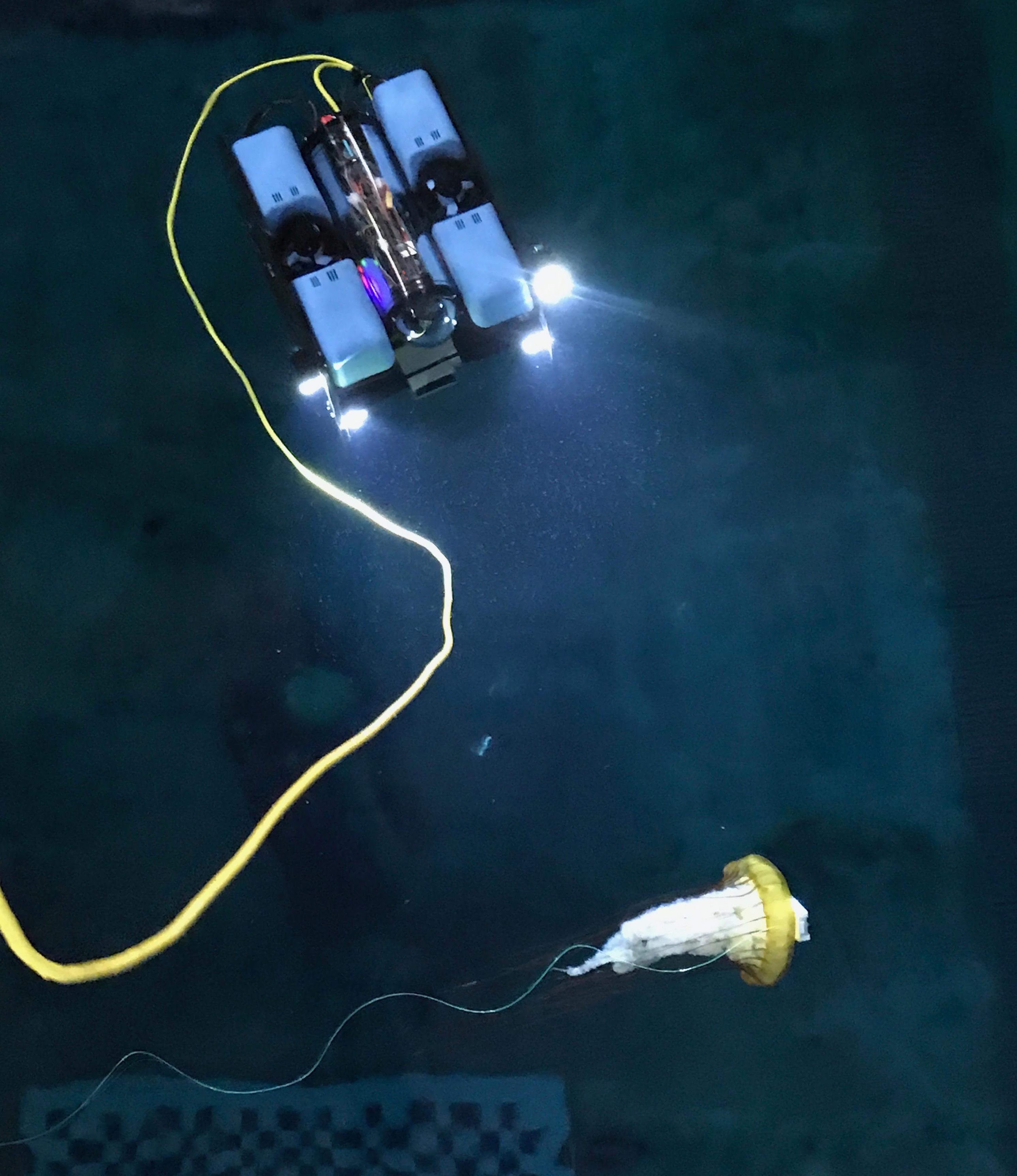
She offered me a job. I took it. Thus began the adventure of being an accidental jellyfish wrangler, which left in me a deep appreciation for experimental biologists in the field and the hourly uncertainties and insanities they endure to get what machine learning people take so often for granted: data. Kakani, whose MO is developing sci-fi technology to investigate deep-sea organisms, hired me to run experiments tagging wild jellyfish with motion sensors and develop methods to characterize behavioral patterns from the resulting data.
The second part turned out to be easy. The first part was not. When your life experience has contextualized the ocean solely in terms of vacation, it can be perplexing and entertaining to learn through fieldwork that the ocean, in fact, owes you nothing. It is a wild, unfathomable vastness that has seen the ages of the Earth. It is above you. And above your scrupulously planned experiment, in which you try to control all the variables you don’t want to observe the effects of. Instead, you end up making a list of all those variables—such as, whether you’ll even be able to relocate and retrieve your tags, after gelatinous invertebrates have dragged them up and down the water column from Moss Landing to Aptos through untamable weather—throw the list away and laugh, and pray for the mercy of the waves. As one MBARI veteran told me after I dejectedly reported that we’d lost our first deployed tag, “The ocean’s hard as diamonds.” Sure enough, it’d be first of five out of thirteen deployments we would fail to gather any data from.
What follows is a reenactment of our last deployment on May 18, 2018, based on my field notes and footage from that day. To set the scene, I’ll first sketch out the main challenge of the experiment and the protocol we came up with to tackle it. After we’d tagged and released a jelly back into the ocean, how would we 1) find and 2) retrieve it again? A GPS module, plus the battery required to operate it for long enough for the data to be meaningful (we were hoping for double-digit hours) would make the tag too bulky to attach to jellyfish, which are also extremely sensitive to changes in buoyancy. An acoustic pinger would require operating receivers, which can be unreliable and imprecise when the jelly’s depth is unknown and varying. Plus, neither a ping nor a GPS signal would resolve the problem of how to actually retrieve the tag if it was, say, fifty meters below the surface, and transmitting the data back to shore runs into the same issues as a GPS module.
In the end, we settled on what probably seems like a ludicrous protocol. We would tether the tag using several dozen meters of fishing line to a drogued surface drifter that contained a GPS tracking device, which would regularly ping its location back to us. Under the traditional, but certainly not uncontested, assumption that jellyfish are bona fide zooplankton, meaning their movement trajectories are by-and-large determined by the surrounding current (at least, at spatial resolutions broader than the length of the fishing line), the current would carry the jellyfish and drifter together along the same trajectory, such that the fishing line wouldn’t interfere with the jellyfish’s movement and would serve only as a retrieval mechanism for the tag.

This necessitated deploying an unwieldy three-part contraption: the tagged jellyfish, tethered by thirty meters of fishing line to a drogue, tied by several meters of rope to a surface drifter. Finally, we would use a BlueROV2 equipped with a GoPro, time-synchronized to the motion sensors on the tag, to track and gather video footage of the jelly. After deploying everything into the ocean—without entangling anything amidst all the fishing line and rope—the goal would be to track it for as long as possible, then retrieve the tag and data the next day. I would then use the video footage to annotate the jelly’s motion data with behavioral labels and develop classifiers, with which we could interpret the wealth of unlabeled motion data generated over the course of the roughly 24-hour deployment.
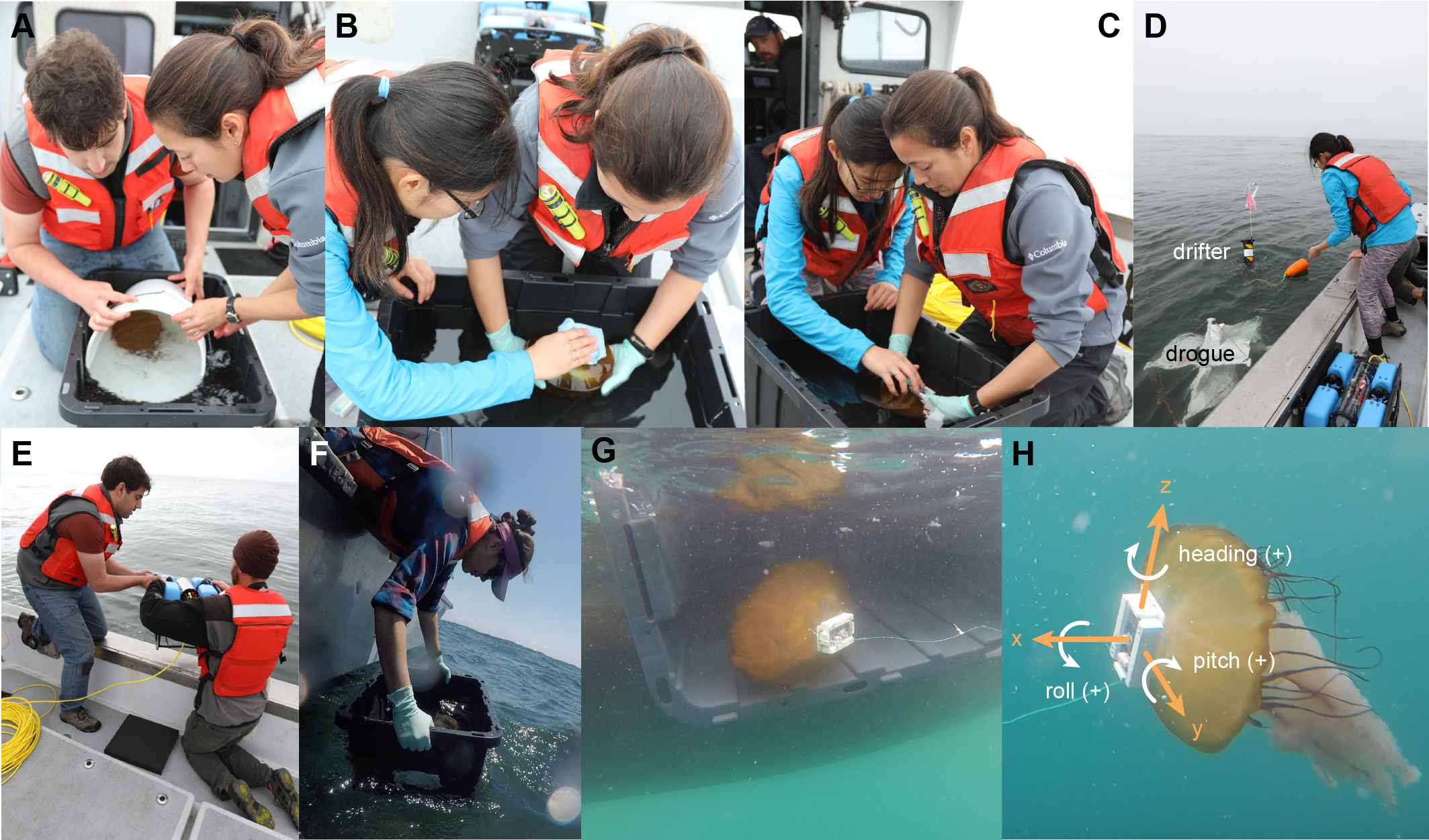
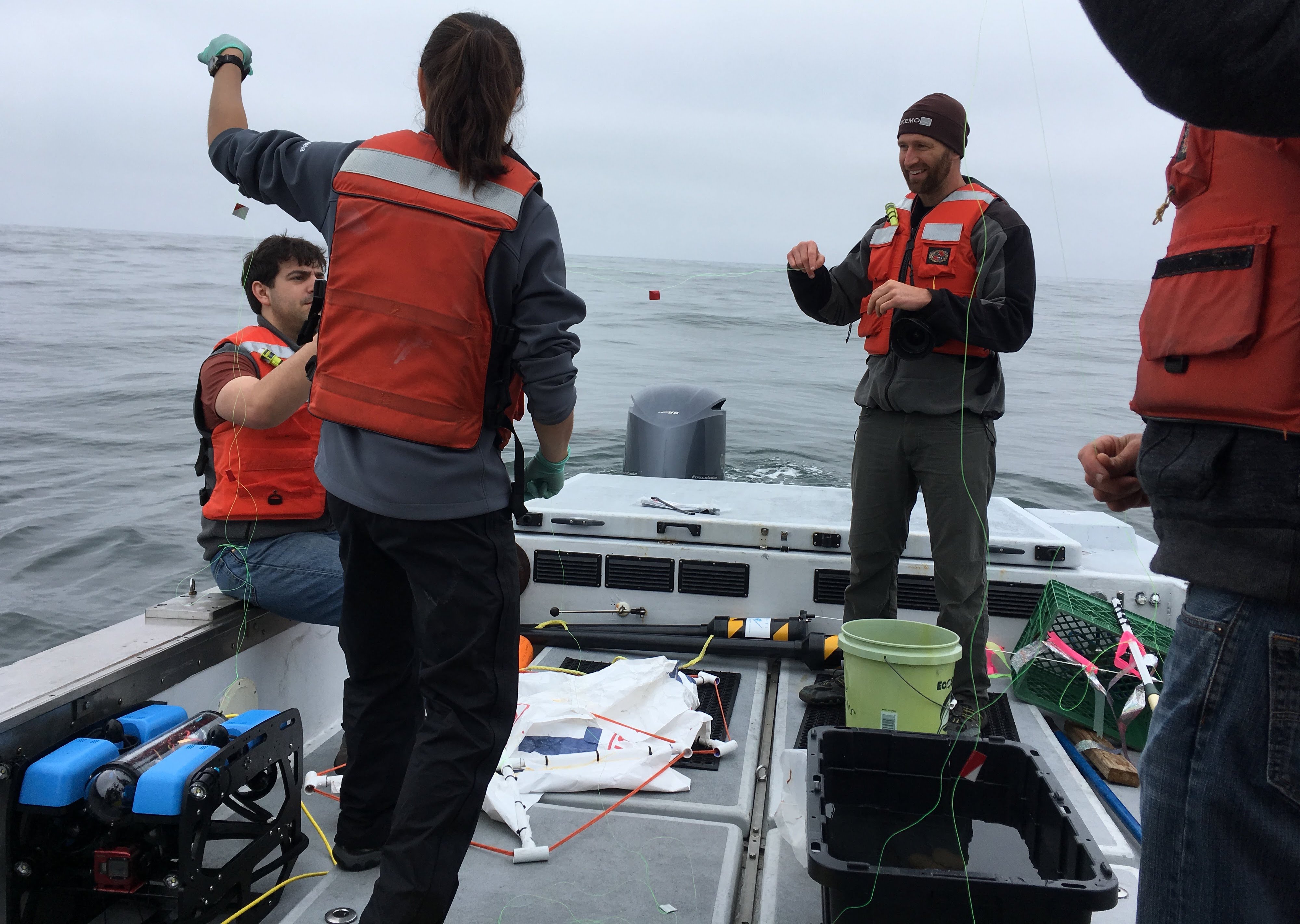
Friday, May 18, 2018. The crew: Kakani, our captain Jared, engineers Tom and Ivan, and me. We set out from the Moss Landing harbor at 8:27am in the Paragon, our anticipation buoyed by the still waters and pristine blue sky. I was feeling good. Last time we’d had perfect weather, we’d finished the day with fifty minutes of the most gorgeous footage of sea nettles superglued to electronic tags tethered by fishing line to surface drifters you could ask for (cue title image!). I would soon learn that those kinds of jackpot days were, in one, the great seduction and torment of fieldwork. When the wild ocean looks on you with mercy and bequeaths the exact phenomenon you’ve spent weeks dreaming of, every other attempt feels like a flailing comedy-drama in comparison. Of course, today would turn out to be of the latter variety.
Out of the harbor, the Paragon carefully puttered around a raft of otters, then sped off toward the horizon, kicking up plumes of white into the brilliant blues encompassing us. We spread out around the deck to watch the water. It’s a childhood instinct that never grows old, even for the Kakanis around me that had built careers on and in the ocean. I loved these moments, my restless mind finally quiet, dazzled and comforted by the eternal horizon before the chaos of the day’s work kicked in.

The plan for these experiments was to put some distance between us and the shallow coast, then start the hunt for sea nettles (Chrysaora fuscescens) in deeper waters, often guided by where Jared had last seen them on fishing trips.
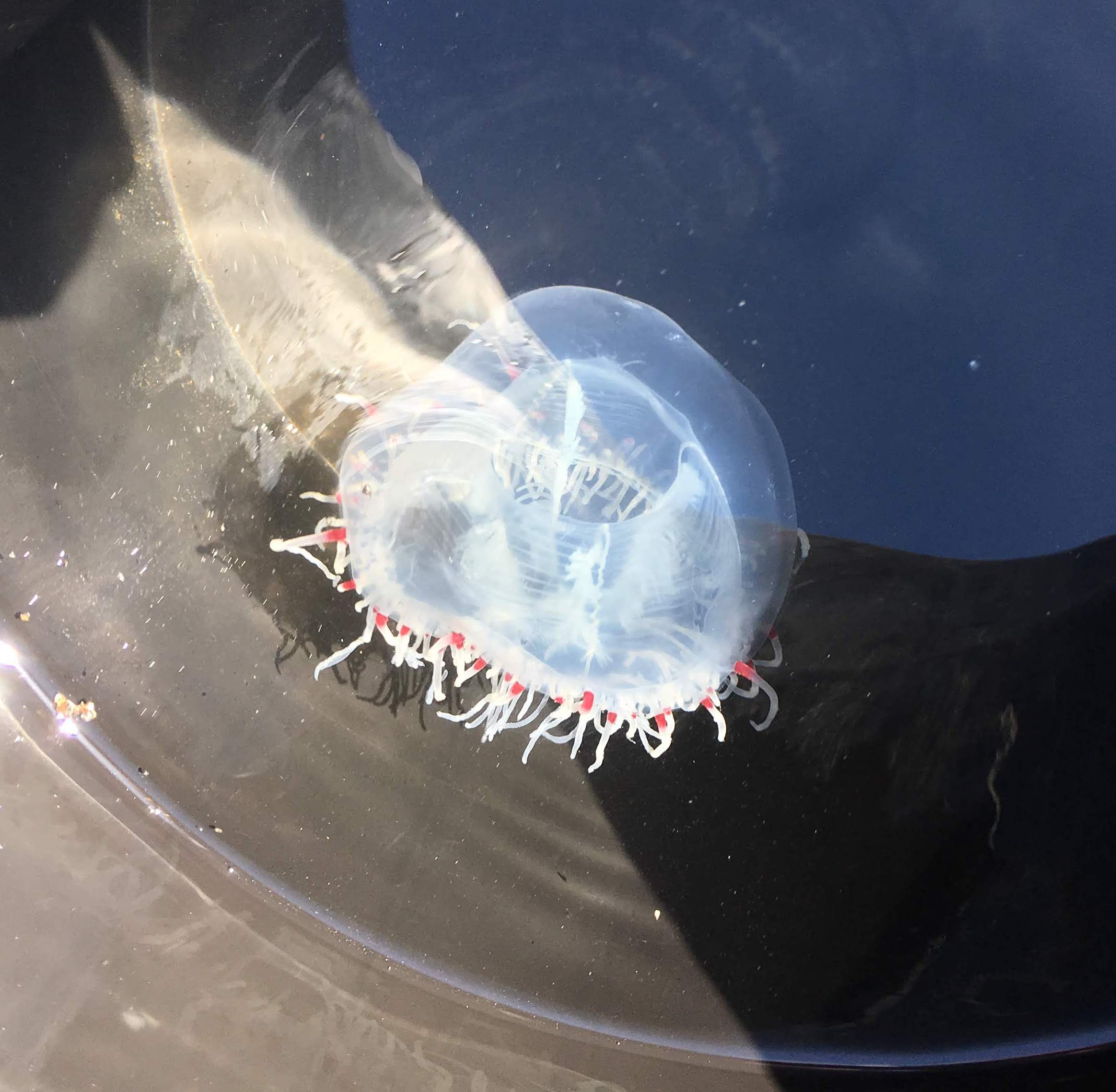
Unfortunately, the rest of the morning was spent victim to the most frustrating and uncontrollable part of the experiment: coaxing destiny to 1) sweep large enough sea nettles to the surface of the patch of ocean that was visible to us, then 2) keep them in place while we bustled over in the Paragon and scooped them without drama into our buckets. Sea nettles have been observed at depths down to several hundreds of meters, and often dive as an escape response, so this was a big ask.
Today, destiny wasn’t in a good mood. We wandered up and down the coastline between Moss Landing and Santa Cruz for a good three hours, finding plenty of Scrippsia, little hydrozoans festooned with bright maroon knobs, but none of the sea nettles Jared had seen swarming just the day before. Ugh.
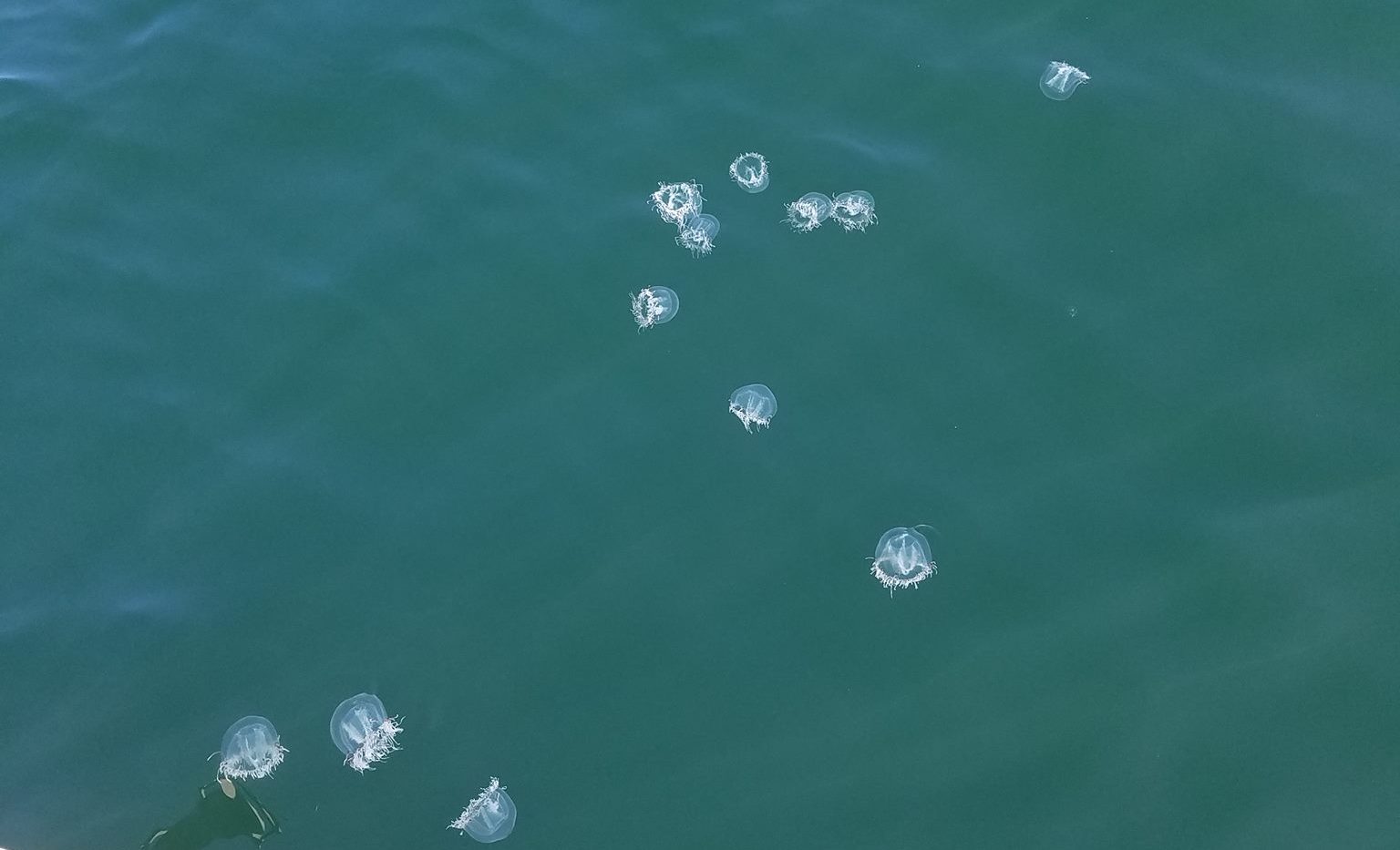
We used the downtime for ocean garbage duty, salvaging almost a dozen balloons from Mother’s Day celebrations the weekend before.
“Well, at least the weather still looks good!” Tom, ever optimistic, pulled out his camera and snapped a few photos of us against the blue.

Turns out, the ocean just hadn’t woken up yet. Wind and waves started kicking in at noon, and still we couldn’t find sea nettles. It was now a race against time. Jellyfish tend to avoid turbulence and would begin to dive out of our grasp. Even if we found them now, the delicate operation of attaching tags to them and releasing a linked contraption of tagged jelly, drogue, and drifter from a rocking vessel without something getting tangled would become much harder—not to mention tracking the jelly with the ROV and recording enough footage for the tag data to be valuable.
Per usual, Jared’s fishing savvy saved us. We dropped his fishing camera into the waves and lo and behold, about three meters down our sea nettle friends swarmed, just barely out of sight from the surface. But how to get to them?
Kakani proposed a trick sometimes used by fellow jelly researchers at the Aquarium. Could we drive the boat in wide circles, so that its wake displaced the surface water? If the water below was laden full of jellies, they would be swept upward to the surface and into our grasp. Sounded worth a try. I clambered up the side of the cabin to watch our frothing wake as Jared put pedal to the metal and drove the boat in an endless circle, about fifty meters in diameter. Sure enough, after a few times around golden bells began drifting up through the churning water. They bobbed around at the surface, probably disoriented as all hell, for maybe half a minute before reorienting themselves downward and promptly diving back into the deep. It was finally jelly-hunting time.
We quickly fell into a routine. Someone would spot a golden bell bobbing somewhere in our circular wake, yell “JELLY!”, and keep their finger pointed at the target while Jared pulled out of the turn and navigated us over, approaching slowly to avoid washing the jelly away. Armed with the best of jelly-hunting tools, primarily a spare paint bucket and milk crate cable-tied to a broom handle, we would then sling our torsos desperately over the sides of the Paragon and try to (gently!) scoop up our quarry with as little drama as possible.
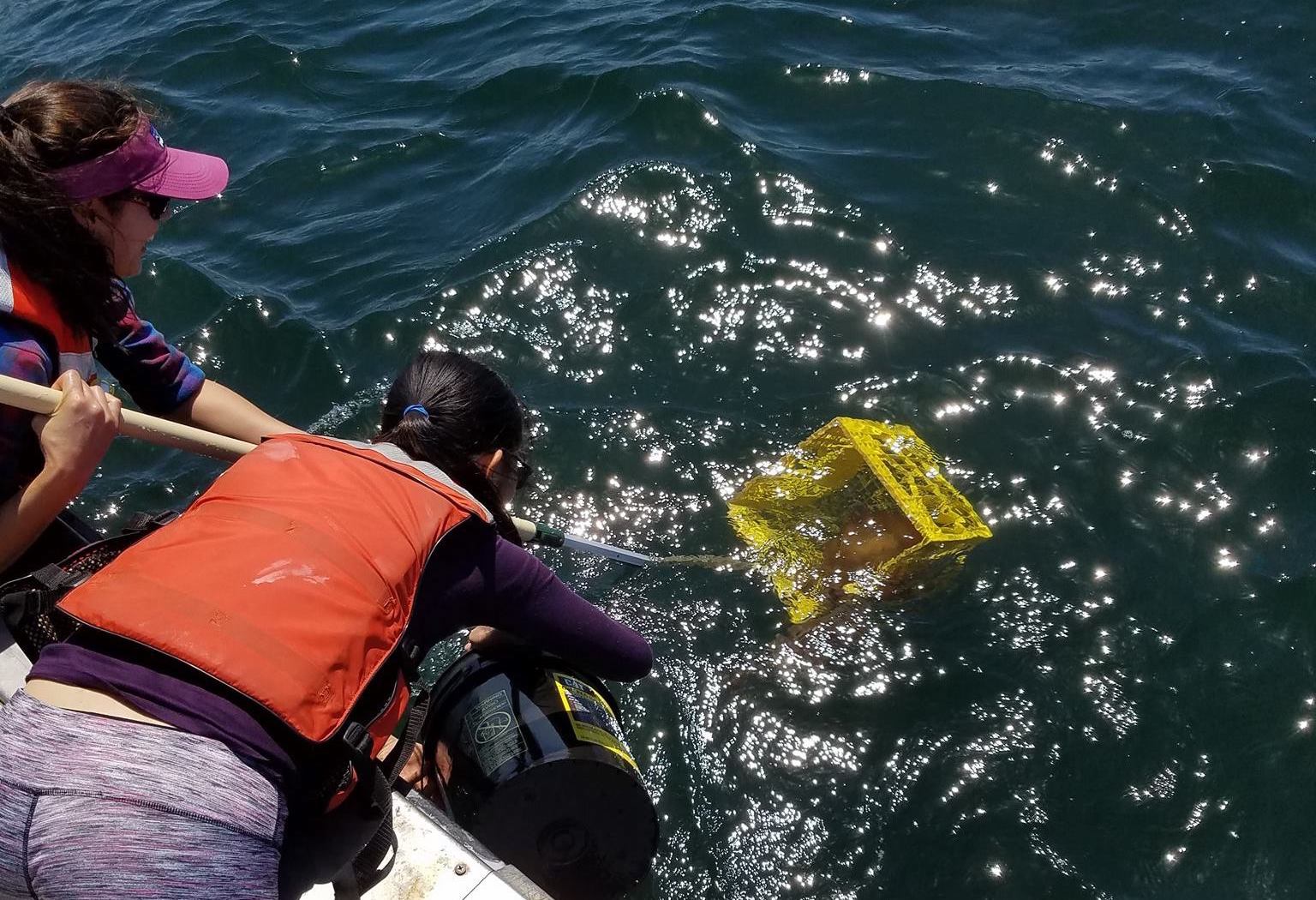
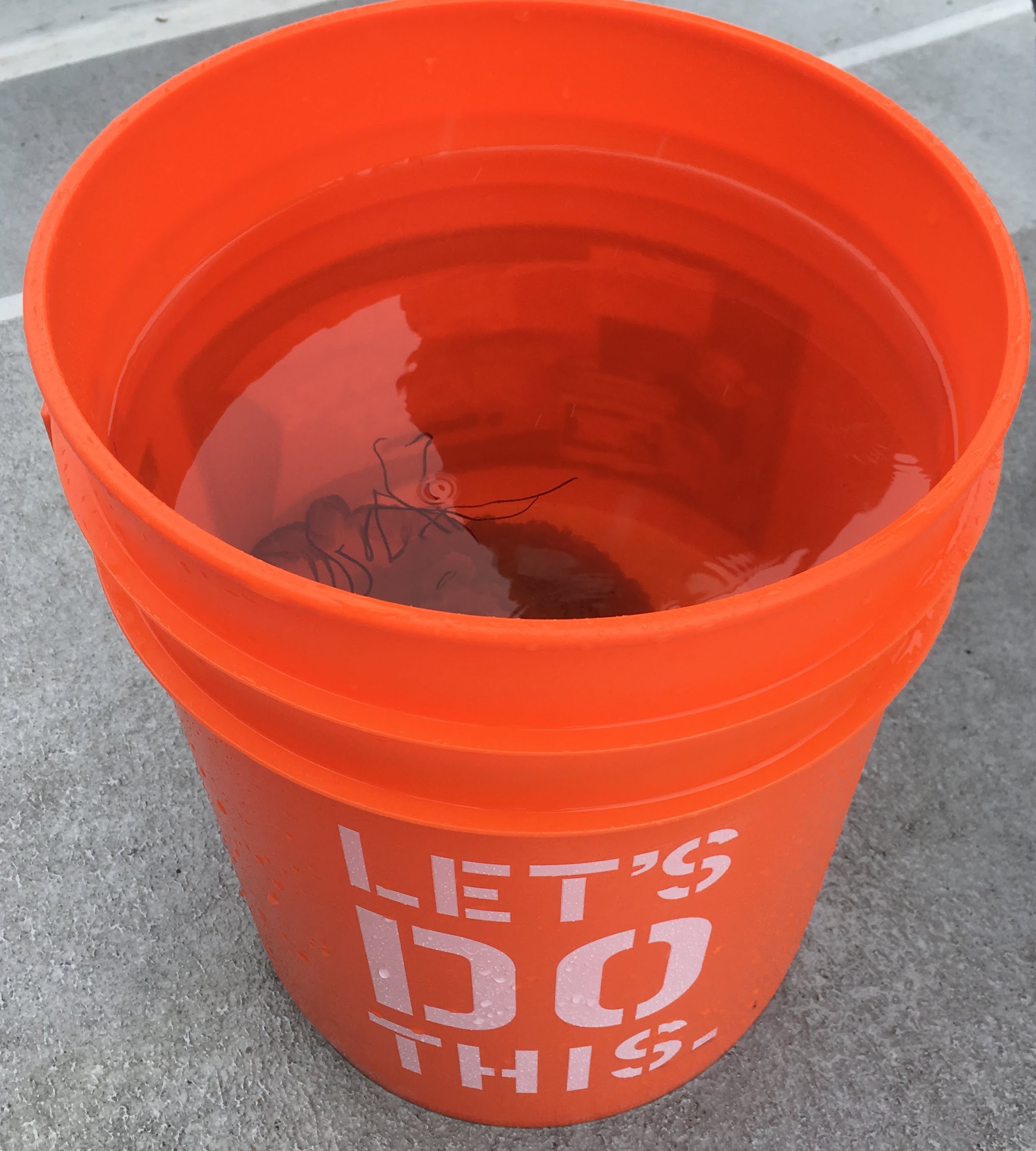
Of course, this led to more than a few comedic breaks and stings—getting a jellyfish bell into a bucket is one thing, but getting its entire entourage of gloopy arms and tentacles in is another altogether.1 Nonetheless, after a few attempts, we’d collected three nice big jellies into a big storage tub of seawater. Now the real fun could begin.
We selected the spunkiest-looking jelly, unceremoniously dubbed it Big Guy, and prepared it for the adventure ahead by gently wiping off the gooey mucus on its bell that would interfere with the tag attachment. I initiated the tag recording, and began attaching one end of fishing line to the tag with a series of clinch knots. As the waves tossed us gleefully to and fro, I carefully superglued2 the tag to the top of Big Guy’s bell while Kakani held it fixed.
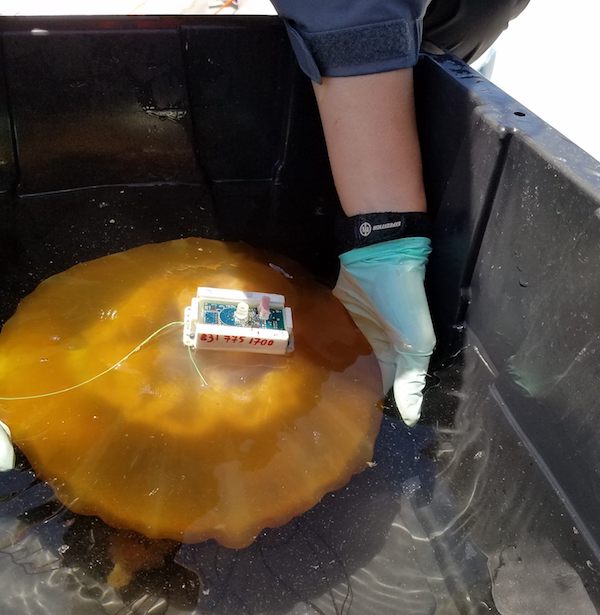
After testing the strength of the tag attachment, we began securing the other end of the fishing line to the drogued surface drifter, a task that was easier said than done on the undulating deck. Fixating on the tiny knots with my head down, I felt my stomach give in. Uh oh. I launched myself to the side of the ship and vomited heartily three times into the boisterous waves, while Kakani and Jared picked up where I left off and finished the clinch knots. After triple-checking all the knots, which would need to literally hold together the experiment for days on end in the tumultuous depths, we were ready for take-off.

We released the drifter into the ocean first, holding onto the fishing line to make sure it didn’t yank Big Guy on the other end, then the BlueROV. Now came Big Guy’s turn. Kakani carefully hoisted the jelly’s tub over the side of the Paragon and held it afloat, waiting for me to take control of the ROV before releasing it.
I stumbled inside the cabin, my eyes desperate to adjust to the darkness as I fumbled for the ROV controller and oriented the ROV to visualize the tub. I had just found it when the ROV software began to spasm, the frames freezing sporadically. Disk space! A memory flashed across my mind of noting that the laptop we’d borrowed with the software had only a few GB of storage left. We were probably knocking into that limit, meaning I had to restart the program and judiciously figure out what to delete from someone else’s laptop to free up space.
Meanwhile, the precious battery lives of both the tag and the GoPro on the BlueROV were steadily ticking away, and the intrepid Kakani was stuck strapped over the side of the ship, holding onto the tub carrying our precious tagged cargo, the waves too volatile for her to haul the tub back onboard without risking sloshing bubbles into its gelatinous tissue. Just watching her made me want to vomit again. Think about literally ANYTHING but that. I quickly decided to delete some subpar footage from previous outings, then quit and restarted the ROV software, only to discover that it now inexplicably wouldn’t recognize the joystick.

After an excruciating sixty seconds of floundering through setting menus, I managed to reconfigure the joystick, and Ivan, who had frantically retrieved the ROV from the waves when the software lost control of it, released it again. I quickly maneuvered the ROV to get the jelly’s tub in the video feed, so we could start tracking. “ROV sees the tub!” I yelled, and Kakani released the jelly into the churning water.
Finally, finally, we could begin collecting some data. I glued my eyes to the screen, determined to track this sucker for longer than the 20 minutes we’d collected last time. The visibility wasn’t good today—the spring upwelling had filled the waters with lush clouds of plankton, and I had to fight to visually distinguish the blob I was tracking from its murky surroundings.
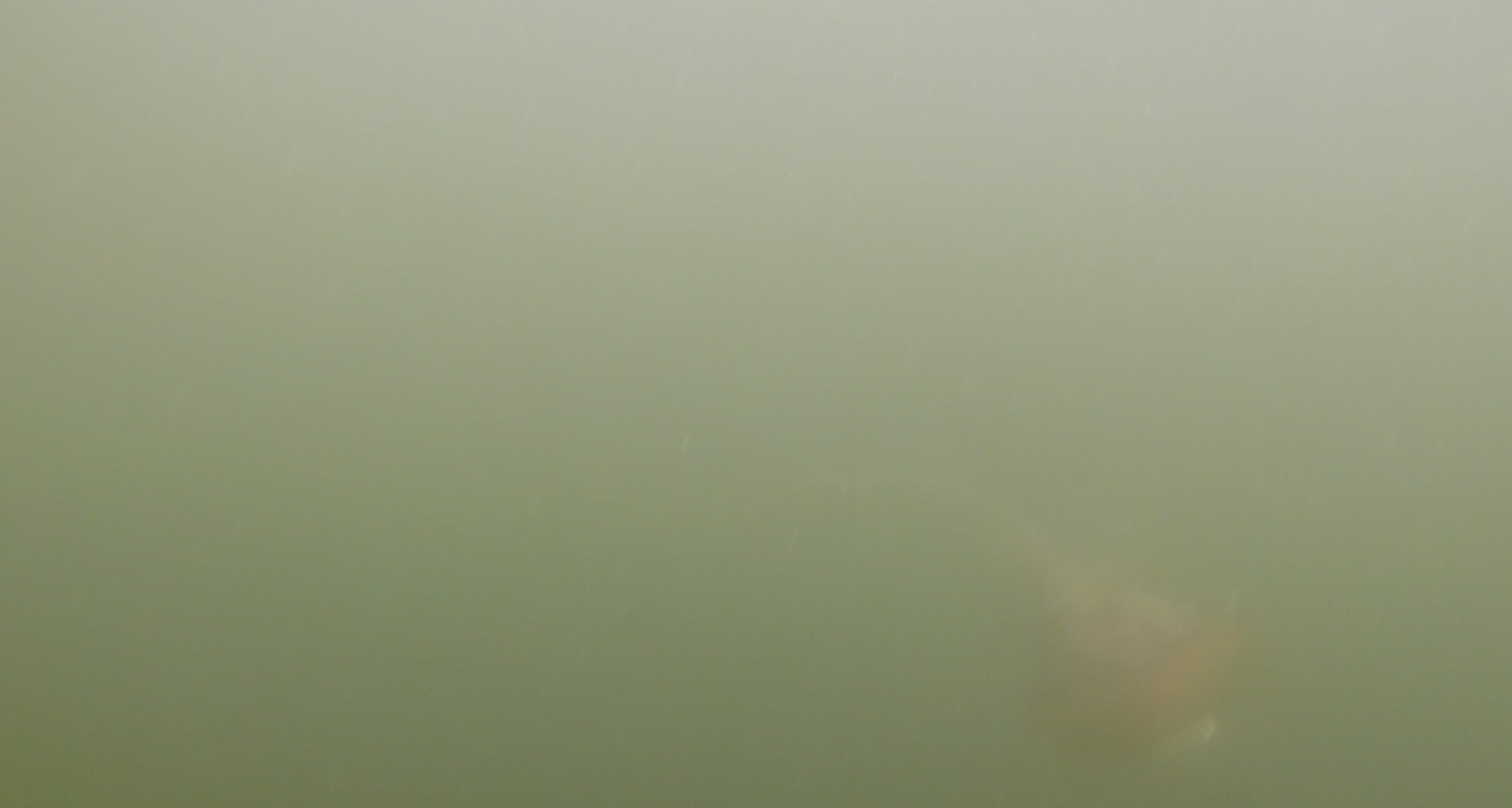
For the next few minutes, half of my mind was occupied with keeping the ROV fixed on Big Guy, who was diving into ever darker and murkier waters full of fellow identical C. fuscescens, while the other half tried to calculate exactly how much ROV time I’d bought by deleting footage and how close we were to using it up.
On the one hand, I wanted to record much video data as possible. On the other hand, if I recorded for too long and ran out of space, the software would crash again, leaving me a corrupted video file that I’d still be able to open with trusty old VLC, but wouldn’t be able to scrub through. That had happened before, and it made manually annotating the second-by-second behaviors in the video a nightmare. This was partly why we’d added a GoPro to the ROV, as it provided high-quality back-up footage. Unfortunately, because the GoPro recording had to be synced with the tag recording, we always had to start the recording before any of the ensuing deployment chaos started, which meant the first ten minutes or more just recorded us preparing and deploying all the equipment. Given that today’s deployment dance had taken much longer than expected, and that the GoPro was useless once its battery or storage was exhausted, I couldn’t necessarily count on any back-up video if the ROV software went down again.
Each minute that went by was excruciating. Should I pull the plug now? But this is our last ever deployment, and we’ve gotta go for everything we can get. But I’m pretty sure I only have around 9 minutes to record, and it’s now been 8 minutes, 20 seconds… 25 seconds… Or maybe I calculated that wrong? The recording I deleted might’ve had a different FPS. Crap, which jelly is my jelly? 8 minutes, 40 seconds…
I was teetering on the verge of calling it quits when the software’s video feed sputtered, then froze. Alas, I’d waited too long. Sigh. “Lost jelly!” I signaled to everyone the run was over. Once we’d reeled the ROV back onboard, Jared pointed the Paragon toward the Moss Landing power plant on the horizon, and back home we headed. Somewhere behind us, one chosen jellyfish pulsed through the depths, crowned with a diadem of blinking sensors, destined—perhaps, maybe, hopefully—to be found by us again the next week.

Post-mortem: Back onshore, we found that the GoPro had run out of battery before the ROV even hit the water. Our reward for the day’s work was the 8 minutes, 43 seconds of lower-quality ROV footage I’d recorded before the software crashed. Thankfully, we did successfully retrieve the tag and its motion data the following Monday, and were able to make use of it and the accompanying video data in our final analysis.
For more gory details, check out our paper (Fannjiang et al. 2019).
-
Pro tip in case you ever find yourself desperately hunting for sea nettles with a milk crate: use the crate to guide the trajectory of the jelly by pumping it back and forth to create a wake directed back at you. The grid-like structure of a milk crate makes it much easier for moving masses of water than, say, a bucket. ↩
-
3M Vetbond Tissue Adhesive, typically used for veterinary purposes. It sloughs off the jelly’s bell eventually. Based on their motion data, several tags lost their jellies this way long before we retrieved them. ↩


